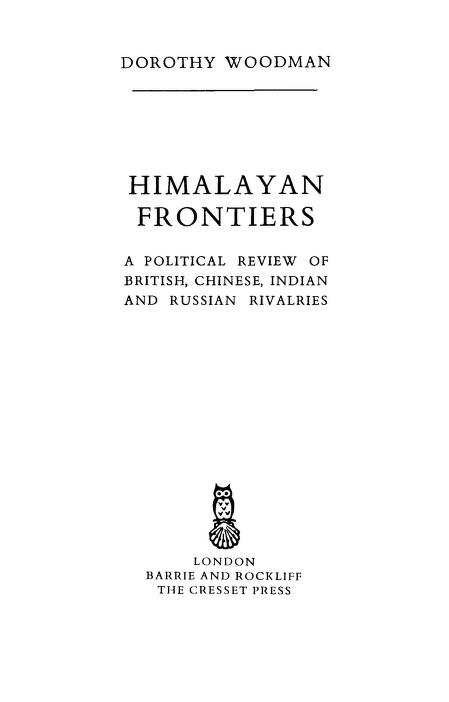Himalayan Frontiers

About
Summary
Exquisite
TOC
Details
Related
URL
Images
Overview
Himalayan Frontiers: A Political Review of British, Chinese, Indian and Russian Rivalries by Dorothy Woodman, published in 1969, delves into the intricate political history of the Himalayan region, examining the rivalries between Great Britain, China, India, and Russia. The book explores how these rivalries have shaped the geopolitical landscape of the Indian subcontinent and continue to influence the policies of modern nations.Woodman's Himalayan Frontiers provides a comprehensive analysis of the historical, geographical, and political factors that have influenced the relationships between the major powers vying for influence in the Himalayan region. The book traces the evolution of these rivalries from the days when merchants crossed the mountains to the era of modern strategic competition. It examines the impact of British colonial expansion, Chinese territorial ambitions, and Russian imperial interests on the smaller states within the Himalayan periphery.
The book covers a wide range of topics, including the historical context of Sino-Indian relations, the establishment of the McMahon Line, and the border disputes that led to the Sino-Indian War. It also examines the role of other regional players such as Pakistan, Nepal, and Bhutan in the complex geopolitical dynamics of the area.
Woodman argues that geographical factors have played a crucial role in shaping the policies of the nations involved, and continue to determine the strategic importance of the Himalayas. She emphasizes that while ideologies and political systems have changed over time, the underlying geographical realities remain constant.
Importance of Book
Historical Analysis: Himalayan Frontiers provides a valuable historical analysis of the political dynamics in the Himalayan region, offering insights into the long-term factors that have shaped the area's geopolitical landscape.
Geopolitical Context: The book helps readers understand the complex relationships between the major powers involved and the strategic importance of the Himalayas in the context of Asian politics.
Understanding Border Disputes: It offers a detailed examination of the border disputes that have plagued the region, shedding light on the underlying causes and potential solutions.
Key Themes
Geopolitical Rivalry: The central theme is the competition among Great Britain, China, India, and Russia for influence and control in the Himalayan region. The book examines how these powers have sought to advance their strategic interests through diplomacy, military force, and economic manipulation.
Colonialism and Imperialism: Woodman explores the impact of British colonialism on the Himalayan region, highlighting how British policies shaped the borders and political structures of the area. She also examines the role of Chinese and Russian imperialism in the region's history.
Border Disputes: The book delves into the complex history of border disputes in the Himalayas, particularly the Sino-Indian border dispute that led to the 1962 war. It examines the various claims and counterclaims made by the parties involved and analyzes the underlying causes of the conflict.
The McMahon Line: Woodman dedicates significant attention to the McMahon Line, a controversial boundary agreement between Britain and Tibet that China has never recognized. She examines the historical context of the agreement and its implications for Sino-Indian relations.
The Role of Smaller States: The book also considers the role of smaller states such as Nepal, Bhutan, and Sikkim in the Himalayan region. It examines how these states have navigated the rivalries between the major powers and sought to protect their own interests.
Cultural Significance
The cultural significance of Himalayan Frontiers lies in its exploration of the intersection between geography, politics, and culture in the Himalayan region. The book highlights how the Himalayas have served as both a physical barrier and a bridge between different civilizations, shaping the cultural identities and interactions of the peoples who inhabit the area. It also touches upon the cultural and religious significance of the Himalayas in Hinduism and Buddhism.
Effects on Society
Informed Policymaking: The book has provided policymakers and scholars with valuable insights into the historical context of the region's conflicts and the long-term strategic interests of the major powers involved.
Academic Discourse: It has contributed to academic discourse on international relations, colonialism, and border disputes, offering a nuanced perspective on the complexities of the Himalayan region.
Public Awareness: The book has raised public awareness of the historical and political dynamics in the Himalayas, helping to inform public opinion on issues such as Sino-Indian relations and border security.
Conclusion
Himalayan Frontiers by Dorothy Woodman is a comprehensive and insightful analysis of the political rivalries that have shaped the Himalayan region. By examining the historical context, geographical factors, and cultural influences at play, the book offers a valuable contribution to the understanding of this strategically important area. It remains relevant for anyone seeking to understand the complex dynamics of Asian geopolitics and the ongoing challenges of border disputes and regional security.
Table of Content
The specific table of contents for \"Himalayan Frontiers\" by Dorothy Woodman, published in 1969. However, I can provide a general overview of the topics typically covered in the book.Overview of Sections:
Geopolitical Context: An introduction to the geopolitical landscape of the Himalayan region, including the historical significance of the area.Regional Studies: In-depth examinations of specific regions within the Himalayas, discussing cultural, social, and economic aspects.Political Tensions: Analysis of the political dynamics between India, China, and other neighboring countries, particularly in light of territorial disputes.Cultural Heritage: Exploration of the diverse cultures and traditions found in the Himalayan communities.Environmental Concerns: Discussion of the ecological challenges faced by the region and the impact of modernization.
Title
Himalayan Frontiers
Author
Dorothy Woodman
Name of Publisher
Barrie and Rockliff London
Publish Date
1969
Subject
The book delves into the historical context and the significance of the Himalayas as a frontier area that has been shaped by both natural and human factors.
Vintage
1948-2000
Category
History
Sub Category
Military
Rarity
RARE
